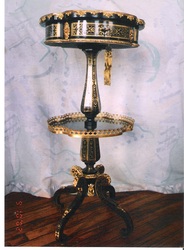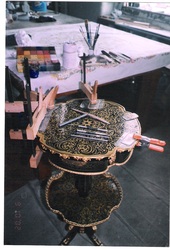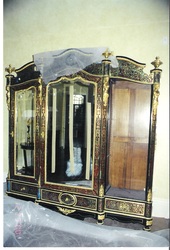Boullework
A technique named after Andre-Charles Boulle that involves the elaborate inlay of brass into tortoiseshell or ebony and vice versa. The process was applied to high quality furniture usually made in matching pairs from the late 17th century.
The problems usually appear due to the completely different properties of the materials and their opposite reactions to heat, cold, and relative humidity. Chemicals used in household for brass polishing solutions can also cause problems. They can cause the glue to deteriorate, while the polishing cloth can get caught on the metal and pull it out of place.
The problems usually appear due to the completely different properties of the materials and their opposite reactions to heat, cold, and relative humidity. Chemicals used in household for brass polishing solutions can also cause problems. They can cause the glue to deteriorate, while the polishing cloth can get caught on the metal and pull it out of place.
|
These furniture had lots of loose brass. Two methods were used in the re-gluing process.
First, the old glue was removed from the back sides of the brass, the shell, and the wood substrate with dentil tools. Where the surface could be clamped, a cork-backed wooden caul was made to conform to the shape of the surface. Animal hide glue was mixed with a small amount of Venice turpentine. Once dried and unclamped, the excess glue was removed using a small brush or Q-tip dampened with warm water. The second method was to use heated hide glue to adhere the shell, holding it in place with dentil picks until the glue set. |



